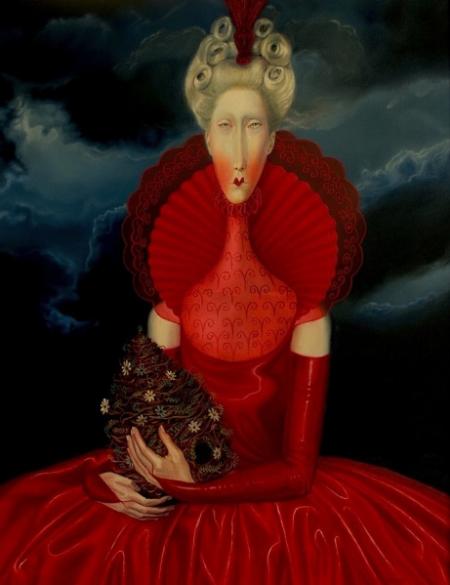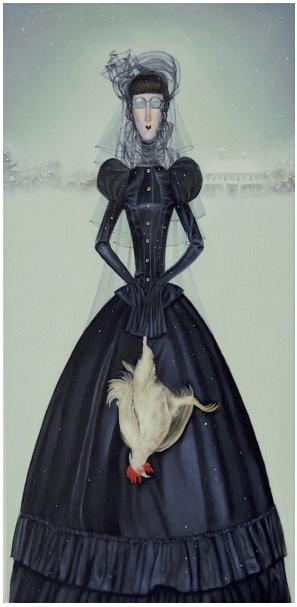This blog is where I reflect on creative processes, creative happenings, creative experiences and creative artefacts.
Dancing with Demons
 Cybele. By Troy Brooks.
Cybele. By Troy Brooks.
A year ago I was on my way to a meeting and I walked passed a small gallery on Queen East. If I wasn't such a punctual person I would have stood there for hours. The woman glared out of the canvas and looked right past me. She was divine. Cold, bewitching–she was otherworldly and yet I felt I knew her.
I wrote the artist's name on a piece of paper – Troy Brooks – and hurried to my destination. When I got home the paper was gone, and with it, the artist's name.
The next time I went past the gallery I was on the streetcar and saw the woman again. I had that same feeling when I saw her and I knew that I needed to meet the person behind her face. I made a special trip to the gallery to get the
information I needed. I pestered the gallery owner and discovered that the artist would be having a show in the fall called Colossus. I went home and fired off an email.
If you have read a few of my blog posts on artists you may have noticed my fascination with their process, their environment and their methodology. I usually try to go to the interview to get a good idea of how they work – a behind-the-scenes of sorts. I like to document studios, sketches, work in progress and inspiration. But ever since my schedule has gone bonkers and I am working relentlessly I must rely on the internet to connect with people which is much less fun.
In light of this situation I asked Troy to describe what a trip to his studio would be like...
"Well, if you were driving here you would have to go through many miles of fields and farm land an hour South of London. The driveway is in between two large wheat fields barely noticeable outside a thick grove of hickory trees. Far from the road at the end of a long driveway sits a large log cabin, which is where I've been since May working on "Colossus." I've made a makeshift studio in the basement. It's so musty that I have to brace myself just a little when I walk down in the morning. It's relatively clean but there are a few spiders I've seen that measure just a wee smaller than my fist. There are wet canvases leaning against walls, on ledges and sitting on scores of old victorian frames that I'm preparing for the show. I've come here from Toronto for the Summer and have since dedicated almost every waking moment to the making of this show."
Not yet titled. Part of the Colossus series. By Troy Brooks.
I was interested in why Troy only seemed to paint women.
"I paint women because, for me, they are ultimately the most visually lyrical subject and to be honest I relate to women much more than I do men. Always have. When I was a teenager I used to spend all day in the town library pouring over books about silent movie actresses. I loved the prostitutes in Van Dongen and Otto Dix paintings. I was obsessed with the 1930's drunken Parisian lesbians in Brassai photographs and the "bitch goddesses" from 40's film noir etc. I amassed quite an extensive collection of old photographs. I made endless drawings of these women. One thing that used to drive me crazy was that I always made the faces too long. It was something I used to have to go back and fix in my drawings. When I began creating my own characters I decided to just accentuate it."
"Colossus is a series of oil on canvas paintings based around the poetry of Sylvia Plath. The paintings are not portraits of Sylvia Plath. I am a painter of women's stories and each painting in this series is a character that surfaces for me in the lines of her poetry. Each is a distinctly different character, but the through-line is that these are all women who have built a passionate choreography out of dancing with their demons. Another interesting element of these characters is the conflict of identity. They are the persona of a delicate young blonde woman in simple settings but wrestling with a savage intellect riddled with complex dark ruminations at a time when young women were supposed to be demure and uncomplicated. That was really interesting to me. The idea of Sandra Dee as William Butler Yeats. These are women much bigger than the rigid social mentality of the 1950's wants them to be. They are at once expanding and in the process of imploding."
Not yet titled. Part of the Colossus series. By Troy Brooks.
On Troy's website I noticed that the paintings that are shown are very recent – 2010. I was curious to know what he was up to before 2010.
"I started drawing at three and I eventually managed to build a good technical ability on my own. By high school I was approached to do commissioned portraits. I liked making the extra money but I hated doing portraits of beige families and children that were carved out of cream cheese. It was enough to make me want to completely avoid a career in art. To this day I hate portraits. Even though my parents both encouraged me to study art after school I decided to study music. For years I was a busy Toronto musician. When I turned 30 I reluctantly realized that the life of a musician just didn't jive with my personal sensibilities and I was tired of being nocturnal."
"Being in the arts is hard enough but changing goals from one occupation prone to poverty to another was more than a little depressing. I went through a horrible experimentation period that felt like starting over from scratch. At the time I didn't have a concept of painting women that made use of my imagination and sense of expression and I spent 5 years painting everything BUT women, trying to find serious subject matter and a visual style. I painted everything from abstract to dark self portraits. What I was really doing was mostly copying other artists and all of it felt contrived. I made a little money doing illustration."
"After that 5 years of experimentation I was a hot mess and decided what I needed was to just move away from painting for a while. Just to get my head clear. I took a few months, which for a productive person is like holding still while you're drowning, but I decided I would only go back to painting when I was ready to just do it for the joy of creating without putting pressure on myself."
Not yet titled. Part of the Colossus series. By Troy Brooks.
"Then in early 2010 I started painting these crazy women, I didn't know what I was doing until I was 5 or 6 paintings in. These pieces were character driven, and what made them so much fun is I started weaving stories into the pieces. This finally became the Virago paintings. I immediately got my first solo show with a great Toronto Gallery and it was really well received. It's amazing how fast it all happened."
One thing that I find fascinating is where people find their inspiration. Colossus is based on the writing of Sylvia Plath but what of the other paintings?
 Widow Merle. By Troy Brooks.
Widow Merle. By Troy Brooks.
"I start with an idea for a character that may be from a book, film, historical figure, someone I've met or heard about etc. Like for instance the painting of "Widow Merle" from the Virago series. She was loosely based on a true story of a victorian woman named Mary Ann Cotton who killed a number of husbands. My symbology is always simple to understand. She's a cold character so she's in a snow storm. She's distant and calculating so her house is far off in the horizon buried under billows of snow. She killed her husband so she's holding a dead cock. I love building the details, like little manifestations of the character's persona."
One of the practices that I encourage in my students is to draw from life. I wondered if these woman could possibly have sprung from a living person or if they emerged directly from Troy's imagination.
"I use a myriad of photographs which can be a bit of a nightmare to blend into one cohesive image. I look forward to the day when I have a model to work with. Many of the women in my paintings have my body parts, for lack of a model."
Troy Brooks at work in his studio.
I know how difficult it is to create fine details with acrylic paints, I can't even imagine how hard it would be with oil paints. Troy manages to pull delicate lacy collars and whisps of fine blond hair out of his oil paint. I needed to know how.
"I work in oils on canvas. I get the fine detail by using watercolor brushes for the fine point work. I go through them fast though as they are obviously not meant to handle oil. I don't use any medium to thin the paint because I hate the smell. I use a non toxic solvent called Turpenoid Natural that has no smell at all and is environmentally friendly."
I am disappointed that I was not able to meet Troy in person and to see the wet canvases leaning up against the wall of his log cabin studio. But I can hardly wait to meet the new women of Colossus.
Colossus will be showing at Pentimento Gallery (1164 Queen St East, Toronto) from October 27th to November 27th 2011.
